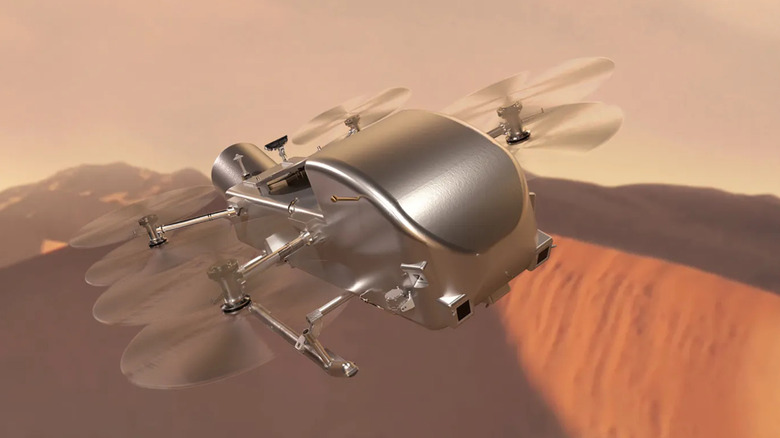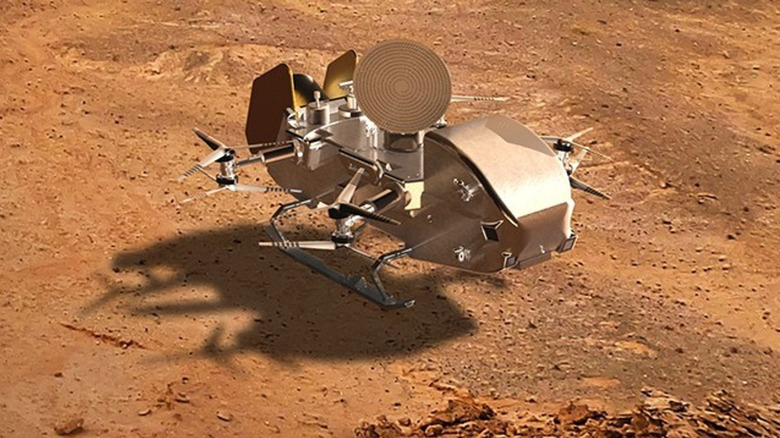NASA's Dragonfly Mission Is Headed To Titan - Here's What You Need To Know
Titan, the largest moon of Saturn, is the only known moon that contains its own atmosphere denser than Earth's, and is the only known object in space other than Earth that contains stable liquids on its surface. Naturally, such a unique world aroused the curiosity of scientists and pioneers for many decades, and soon enough, we might send a drone there.
Codenamed "Dragonfly," NASA collaborated with Johns Hopkins University's Applied Physics Lab to assemble the vehicle for what the team describes as a long-running chemical experiment. Dragonfly is a rotorcraft, with artists' concepts depicting something not unlike a typical drone quadcopter we're used to seeing flying through Earth's atmosphere. It is the first purpose-built rotorcraft designed for interplanetary exploration, with mission parameters, fabrication plans, and test runs already approved. So all that's left now is to actually assemble the craft. It'll be the latest in the many advancements of drone technology in recent years.
Dragonfly's mission statement includes exploration of Titan's surface, cataloging its unique chemistry to learn about the origins of life. According to Sarah Hörst, co-investigator on Dragonfly's science team and Johns Hopkins University atmospheric chemist, "It's essentially a long-running chemical experiment... That's why Titan is exciting. It's a natural version of our origin-of-life experiments — except it's been running much longer and on a planetary scale." In other words, Titan's conditions represent the early stages of organic chemistry which precede life. Since we can't go back millions of years to analyze how life came to be, moons like Titan provide us a rare glimpse into that in real-time. Let's dive in and take a look at the mission and Dragonfly in-depth.
Dragonfly's mission parameters
Titan is easily one of the most unique bodies known to exist. It's the second-largest moon in our solar system behind Jupiter's Ganymede, and the only body with a complex atmosphere suitable for life. Unlike our nitrogen atmosphere, however, Titan's is methane-based, with lakes of liquid methane and ethanein addition to water, cooled to average temperatures of minus 292 degrees Fahrenheit. Obviously, no natural conditions mimicking this exist on Earth, so no life as far as we know can flourish in such an environment. But that doesn't mean that life won't find a way. Titan is an extraordinary case of a body containing the building blocks of life, moving in slow-motion. It's like a petri-dish taken from an early, unfamiliar time, with organic materials in a primordial soup.
Dragonfly seeks to explore this world up-close and personal. Titan has been analyzed numerous times in the past, most famously by the Cassini mission, which revealed the oceans of liquid methane and ethane on the surface. The probe performed over 100 flybys of Saturn's largest moon, recording most of the information we know today. All that's left to do is land there and retrieve samples, analyzing the organic material for potential evidence of life in its earliest stages. According to planetary scientist and principal investigator for Dragonfly Zibi Turtle, "You need to have gone from simple to complex chemistry before jumping to biology, but we don't know all the steps... Titan allows us to uncover some of them." It's just one of many amazing new projects NASA's currently researching today.
Dragonfly's functionality, who's developing it, and how it'll get to Titan
NASA engineers are constructing a rotary-wing drone-type spacecraft housing all the equipment necessary for analyzing the chemical composition of Titan's surface. It's designed to fly from site to site, initially landing in the Selk crater, a 50-mile wide impact site which potentially houses liquid or frozen water and organic material. The spacecraft will analyze samples from various points along the surface, looking for evidence of prebiotic life among Titan's waters.
The Selk crater housed these elements for potentially tens of thousands of years, according to NASA scientists. It's substantially less time than it took for life to develop on Earth, measured in the millions of years. But prebiotic organic chemistry had to occur at some point, and Titan may offer humanity a glimpse of that unique timeframe. As such, the Dragonfly rotorcraft will primarily conduct experiments to see if life could theoretically flourish here, or indeed already is.
In order to get there, NASA is working with SpaceX to send Dragonfly to the moon's surface with a launch date of no earlier than July 2028, on board a Falcon Heavy rocket from Launch Complex 39A at the Kennedy Space Center. Numerous organizations within and outside of NASA are actively collaborating to make the vision a reality, including NASA's Jet Propulsion Laboratory, the Langley Research Center, Penn State University, JAXA (Japan Aerospace Exploration Agency), and more. As of now, we only have artists' conceptions of the finished craft. But with a launch date set in just a few years, we likely won't have to wait long for a physical model to debut.


